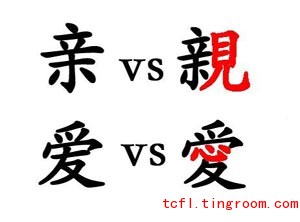During the ongoing "two sessions", Chinese director Feng Xiaogang suggested schools should teach traditional Chinese characters that contain cultural connotations.
今年“两会”的分组讨论中,冯小刚呼吁在中小学的课本里恢复部分有文化含义的繁体字。

 As a member of the Chinese People's Political Consultative Conference (CPPCC)(政协委员), Feng proposed(提议) reviving 50 to 200 most meaningful traditional characters(繁体字) in the textbooks. He said this would not give the children too much pressure, and at the same time would allow them to capture the essence(精华) of Chinese culture.
As a member of the Chinese People's Political Consultative Conference (CPPCC)(政协委员), Feng proposed(提议) reviving 50 to 200 most meaningful traditional characters(繁体字) in the textbooks. He said this would not give the children too much pressure, and at the same time would allow them to capture the essence(精华) of Chinese culture.
He also cited two examples(举例). The traditional character for 亲(qin; meaning "to be close to someone") is 親, whose right part is 見 (jian, the traditional character for 见, meaning "to see"). The traditional character for 爱(ai, meaning love) is 愛; and there is a 心 (xin, heart) in it.
Feng said the traditional Chinese characters are telling us that to be close to someone, you have to meet them, and to love someone, you should have a heart, but the simplified Chinese characters(简体字) miss the meanings.
The proposal(提案) stirred a heated discussion in the group meeting, as well as on Chinese social media. A sample of comments on Weibo:
@Flower-rainbow: The structures(结构) of many traditional characters clearly imply their meanings and Chinese culture. I absolutely agree with Feng.
@Jianghuke: Traditional Chinese is the soul(灵魂) of Chinese characters, especially for Chinese calligraphy(书法).
@Flying-duck: Culture should keep up with the times, and times are changing! We should simplify(简化) our lives. We have adjusted to(适应) the simplified characters already, why bother with the traditional ones?
重点词汇Key Words:
繁体字 fán tǐ zì
traditional Chinese characters
简体字 jiǎn tǐ zì
simplified Chinese characters
提议 tí yì
propose/proposal
v. Eg. 我提议为两国人民的友谊干杯。
I propose a toast to the friendship between the peoples of the two countries.
n. Eg. 这个提议绝不会理所当然地获得通过。
This proposal is by no means a sure thing.
 English
English Japanese
Japanese Korean
Korean French
French German
German Spanish
Spanish Italian
Italian Arab
Arab Portuguese
Portuguese Vietnamese
Vietnamese Russian
Russian Finnish
Finnish Thai
Thai dk
dk